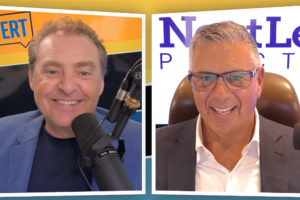YouTube Video Link: www.MrBz.com/GaryKadi
Did you know that 96% of dentists are not financially able to retire at age 65? According to the American Dental Association, the average dentist retires at 69, which is eight years later than the average American.
Why is this happening? It’s because dentists are overworked and underpaid. Over the last 20 years, dentists’ income has remained flat or declined.
I recently interviewed Gary Kadi, CEO of NextLevel Practice and author of “Million Dollar Dentistry.” Since 1996, he’s been building systems, tools and training for general dentists who hate staring at P&L statements, accounting software, financial systems, and managing teams, so they can focus on what they’re great at and love doing.
He’s helped over 6,000 practice owners build, grow and scale their practices. Many of them doubled and tripled their revenue shortly after working with Kadi, with less chairside hours. They work on their businesses rather than in their business, and reduce their workweeks from six days a week to three and a half or less.
His five-step system helps any general practitioner — rural or city, big or small — find money hidden in plain sight. It works during pandemics, in up years and down years, and through personal breakdowns, divorces, and team members leaving. (Even if you’re not a dentist or don’t work in the dental world, every business owner can benefit by modeling Kadi’s lessons.)
In the 90s, Kadi was in the direct marketing business, bringing patients to the front door of dental practices, then watching them go out the back door, never to return. Neither the patients nor the dental teams wanted to be there. Worse yet, most of the time the dentists themselves didn’t want to be there because they were forced into running a monster of a business, which they didn’t learn how to manage in medical school.
Kadi’s direct marketing business grew bigger than he could handle, and because he didn’t understand the infrastructure of a business as it scales, he faced bankruptcy. What Kadi was good at was listening to people: helping them get more of what they wanted and less of what they didn’t.
Over the years Kadi has seen the same patterns emerge in failing dental practices. Here they are:
5 Ways Dental Practices Fail and How to Fix Them:
- Micromanaging and Fractured Leadership: “Ninety-nine percent of dentists are micromanagers,” Kadi told me, which causes them to unintentionally create problems within their business by trying to control all business activities. This isn’t their fault: most dental school programs don’t train students how to be business owners or managers. Leadership training, including how to recruit talent and manage teams, is essential for dental practice owners to address this capability gap.
- Lack of Systems: Most dentists don’t have systems in place. They use the old model of “drill, fill, and bill,” focusing their business entirely on new patient acquisition. Solid systems that build accountability and empower care teams to self-improve are key. With a systems-focused foundation, dentists can block out time to work on the business, focus on differentiating their patient experience, and discover new ways to improve patient retention (and sustainable revenue).
- Fear of Numbers: Many of the dentists Kadi works with are afraid to get mired in their bank accounts, financial statements, accounting software, and patient analytics. Overcoming this fear is essential — even if it requires you to hire someone who loves numbers. Make it a point to get monthly reports and understand how your business functions.
- Over-Reliance on the Practice Owner: In many dental practices, the owner is the high-performing center of the business, and their direct action or involvement is needed to move the business forward. If the owner suffers from burnout or needs to step away from the practice for personal reasons, the business is at risk. Kadi built a “Line in the Sand” process to help hard-charging dentists decentralize themselves, set new practice policies, and achieve buy-in from their teams.
- No Training Support: Technology, the business climate, the economy, and health practices are all evolving quickly. It’s essential practices have systems in place to train and support their teams to keep up with the times.
Kadi’s work over the last 24 years has transformed how dentists do business. He and his team clean up existing messes, institute new structures and systems, align the teams, and let dentists focus on the things they’re good at and have fun doing. Over 20,000 practice owners have completed the training, increasing their collections to over $1 billion and treating over 30 million patients while reducing their total work days.
To learn more about Gary Kadi, get a copy of his book, and access the free “Money in Plain Sight” toolkit mentioned in the video interview, visit: www.NextLevelPractice.com/Free
Watch our whole YouTube interview here: www.MrBz.com/GaryKadi
This is a Contributor Post. Opinions expressed here are opinions of the Contributor. Influencive does not endorse or review brands mentioned; does not and cannot investigate relationships with brands, products, and people mentioned and is up to the Contributor to disclose. Contributors, amongst other accounts and articles may be professional fee-based.

